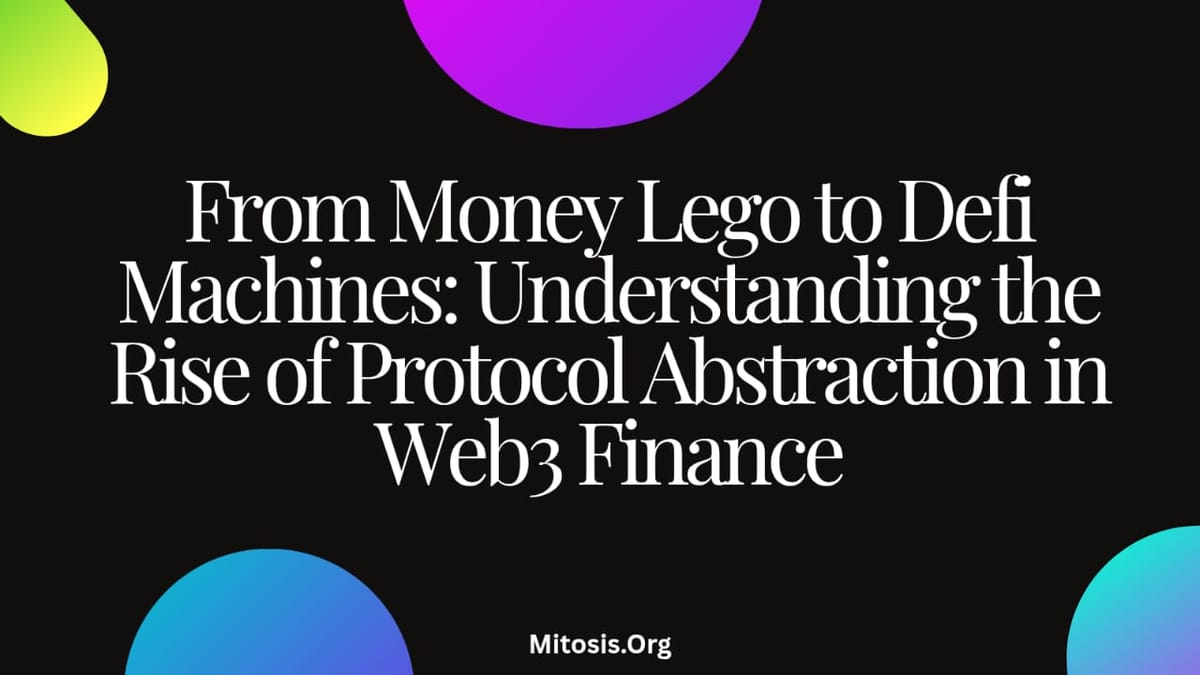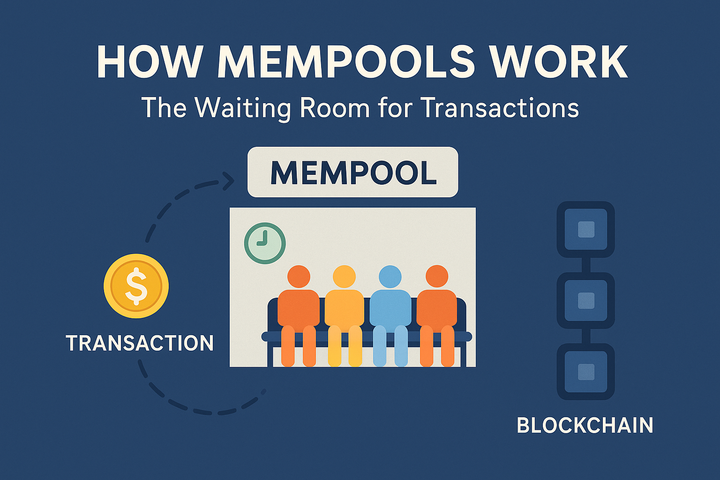From Money Lego to Defi Machines: Understanding the Rise of Protocol Abstraction in Web3 Finance

Introduction: The Evolving Shape of Defi
Decentralized Finance (DeFi) emerged as a revolutionary force, dismantling traditional financial barriers and introducing a new paradigm of open, permissionless financial services. Initially characterized by "money legos", DeFi allowed users to stack various protocols like lending platforms, decentralized exchanges (DEXs), and yield farms to create complex financial strategies. However, as the ecosystem matured, the limitations of this approach became evident: user experience complexities, fragmented liquidity, and scalability challenges.
Enter protocol abstraction a design philosophy aiming to streamline DeFi interactions by encapsulating complex processes into simplified, user-Friendly interfaces. This shift is not merely a UX enhancement but a fundamental evolution in how Defi operates, making it more accessible and efficient. At the forefront of this transformation is Mitosis, a Layer 1 blockchain designed to redefine liquidity management through programmable, cross-chain solutions.
1.0. The Early DeFi Era: Manuel, Transparent, Fragmented
In the nascent stage of DeFi (circa 2018-2011), the ecosystem was a mosaic of standalone protocols. Users manually navigated through various platforms to execute financial strategies: depositing assets into lending pools, swapping tokens on DEXs, and staking LP tokens for yield farming. While this modularity fostered innovation, it also introduced significant friction:
- Complexity: Users needed to understand intricate protocol mechanics and manage multiple transactions across different platforms.
- Fragmentation: Liquidity was scattered across various chains and protocols, leading to inefficiencies.
- Accessibility: The steep learning curve deterred non-technical users, limiting DeFi's mainstream adoption.
This era, while groundbreaking, highlighted the need for more integrated and user-centric solutions.
2.0. Why Abstraction Became Necessary
As DeFi expanded, the challenges of its fragmented architecture became more pronounced. Users faced "DeFi fatigue," overwhelmed by the complexity of managing assets across multiple protocols and chains. Moreover, the inefficiencies in liquidity utilization and the risks associated with manual operations underscored the need for a more streamlined approach.
Protocol abstraction emerged as a solution, aiming to:
- Simplify User Experience: By encapsulating complex operations into intuitive interfaces, users could engage with DeFi without deep technical knowledge.
- Enhance Liquidity Efficiency: Abstracted protocols could optimize asset allocation across platforms, maximizing returns.
- Improve Security: Reducing manual interactions minimized the risk of user errors and potential exploits.
This evolution mirrors traditional finance, where users interact with simplified interfaces, oblivious to the complex backend operations.
3.0. Layers of DeFi Abstraction: A New Stack Emerges
Protocol abstraction in DeFi can be dissected into several layers:
- User Interface (UI) Abstraction: Platforms like DeBank and Zapper aggregate data from multiple protocols, providing users with a consolidated view of their assets and activities.
- Execution Abstraction: Protocols such as 1inch and Matcha route trades across various DEXs to ensure optimal pricing, abstracting the complexities of trade execution.
- Strategy Abstraction: Yield aggregators like Yearn Finance automate investment strategies, allowing users to earn optimized yields without manual intervention.
- Cross-Chain Abstraction: Solutions like Thorchain and Anyswap facilitate seamless asse' different block sfers across , hiding the intricacies of cross-chain operations.
These layers collectively contribute to a more cohesive and user-friendly DeFi ecosystem
4.0. The Role of Middleware and Runtime Protocols
Middleware solutions serve as the connective tissue in the DeFi ecosystem, enabling interoperability and enhancing functionality:
- Cross-Chain Communication: Protocols like LayerZero and Axelar facilitate secure and efficient message passing between blockchains, essential for cross-chain DeFi operations.
- Runtime Environments: Platforms such as Mitosis introduce programmable nments where financial logic c. e deployed dynamically, allowing for real-time strategy adjustments and enhanced composability.
These innovations are pivotal in transitioning DeFi from isolated protocols to an interconnected network of financial services.
5.0. Use Case Spotlight: Auto-Yield Wallets
Auto-yield wallets epitomize the benefits of protocol abstraction. By integrating yield-generating strategies directly into wallets, users can earn returns on their assets without active management. Examples include:
- Brahma Console: Offers automated yield strategies interface, simp engagement.
- Steer Protocol: Provides infrastructure for developers to build automated DeFi strategies, which can be integrated into wallets for seamless user experiences.
These solutions abstract the complexities of yield farming, making DeFi more accessible to a broader audience.
6.0. Risks and Trade-Offs in Abstraction
While abstraction enhances usability, it introduces certain risks:
- Opacity: Users may become unaware of the underlying operations, potentially leadir to blind trust in protocols.
- Smart Contract Risks: Abstracted protocols rely heavily on smart contracts; vulnerabilities can have amplified effects.
- Centralization Concerns: Some abstraction layers may introduce centralized points of failure, contradicting DeFi's decentralization ethos.
Mitigating these risks requires transparent protocol designs, rigorous audits, and user education areas where Mitosis University plays a crucial role.
7.0. Developer Paradigm Shift: From Siloed Products to Financial Primitives
The move toward protocol abstraction isn’t just a UX or design-level shift—it’s a complete rewrite of how developers build in DeFi.
In the earlier DeFi eras, teams built isolated, monolithic products—single-purpose dApps like a lending protocol, an AMM, or a vault strategy. Each project was self-contained, often maintaining its own front end, backend, tokenomics, and liquidity incentives. Integration with other protocols was optional or handled post-deployment.
Abstraction breaks this mold.
Now, developers are incentivized to build composable primitives—modular financial logic that can plug into other systems dynamically. These primitives are not complete dApps but reusable building blocks: fee routers, rebalancers, volatility scalers, auto-rollover logic, strategy schedulers, etc.
What makes this paradigm powerful:
- Composable Ecosystems: Instead of competing for users, developers contribute to ecosystems where their logic can power multiple frontends, wallets, or protocols.
- Higher Leverage per Line of Code: A well-designed primitive can be used across 10+ protocols, without needing its own liquidity mining campaign or full-stack deployment.
- Protocol-as-a-Service (PaaS): Think of DeFi as infrastructure. Instead of launching tokens, developers deploy logic modules and earn protocol fees or share of yield wherever integrated.
Platforms like Mitosis provide the ideal environment for this. Its runtime and liquidity engine allow developers to publish open strategies that tap into shared vaults essentially a plug-and-play “DeFi operating system.”
This shift is already redefining who can build and earn in DeFi. A single Solidity dev can now earn yield by contributing a rebalancing function that ends up powering millions in TVL across dozens of integrations.
8.0. Mitosis: Infrastructure for the Abstracted Future
Where does Mitosis fit in this fast-changing DeFi map?
Mitosis is not just a chain—it’s a liquidity coordination layer that enables:
- Cross-chain liquidity deployment
- Runtime execution of strategies
- Modular yield architectures
- Permissionless strategy publishing
At its core is the idea of programmable liquidity: vaults that can ingest multiple strategies and allow dynamic routing of capital based on user profiles, market data, and risk constraints.
This enables a future where:
- A developer publishes a “yield-maximizing” strategy
- A vault routes 5% of its capital to test it in real-time
- If it outperforms, more capital is allocated dynamically
- Users don’t need to know or touch any of the backend logic
On Mitosis, execution is abstracted, but logic is open—you can inspect what strategies a vault uses, who authored them, what gas they consume, and what they’ve returned over time.
This is radically different from current DeFi yield vaults, which either obscure their inner workings or hard-code strategies into governance-approved contracts.
With Mitosis, strategy markets become open source marketplaces of alpha, allowing a new generation of creators to monetize and iterate on financial code.
9.0. The Cross-Chain Mandate: Abstraction Across Realms
True DeFi doesn’t live on one chain.
Mitosis understands this deeply and builds for a future where capital doesn’t just move across chains, it operates simultaneously across them.
That’s why Mitosis is engineered to support:
- Cross-chain execution: A vault on Ethereum can execute a strategy on Arbitrum without the user ever bridging manually.
- Shared liquidity: Assets are pooled across chains and allocated dynamically where the best opportunities are.
- Strategy routing: A single strategy may utilize liquidity from multiple chains in a single atomic sequence.
This multi-chain architecture turns DeFi into a liquidity cloud, where strategies aren’t siloed and yield isn’t gated by chain-specific arbitrage.
Abstraction here isn’t a shortcut—it’s the only path to making cross-chain yield feasible at scale.
10.0. The User’s View: Simplicity, Optionality, and Confidence
While the backend becomes more complex, the user’s interface becomes beautifully simple.
The end-user on Mitosis doesn’t worry about:
- Which chain a strategy is on
- Which protocol a vault integrates
- Which LP pool has the best APR this week
They select a goal: “Maximize stablecoin yield within low risk” or “Auto-rotate into best blue-chip token strategy.”
Behind the scenes:
- Logic is composed from open-source modules
- Liquidity is routed across networks
- Rebalancing and monitoring is done by protocols
The result? A bank-grade experience that feels like having a full-stack wealth manager—but powered entirely by decentralized, permissionless code.
Users retain full custody, full visibility, and full control, but without the mental overhead.
11.0. From Coordination Failure to Coordination Engine
DeFi is often defined by coordination failure—liquidity trapped across chains, yield fragmented across protocols, strategies competing for the same capital.
Mitosis aims to flip that narrative.
By serving as a coordination engine, it enables:
- Developers to publish once and earn across the ecosystem
- Vaults to optimize capital dynamically across strategies
- Users to access outcomes, not tools
This creates a liquidity singularity, where resources flow toward optimal outcomes, not arbitrary silos.
In essence, Mitosis becomes the keystone of an abstracted DeFi economy, a protocol that turns fragmented DeFi into a living, evolving machine.
Conclusion: The End of DeFi as We Know It (And Why That’s a Good Thing)
We’re at the cusp of DeFi’s third wave.
- The first was protocol primitives (Uniswap, Aave, Compound)
- The second was yield optimization (Yearn, Convex, Pendle)
- The third is abstracted finance, where logic is modular, execution is decentralized, and outcomes are composable.
Mitosis is not just adapting to this future, it’s building it from the ground up.
With a runtime that enables strategy abstraction, cross-chain vault execution, and open liquidity coordination, Mitosis lays the foundation for a financial internet that’s smart, simple, and sovereign.
For users, this means intuitive DeFi with the power of complexity under the hood.
For developers, it’s a shift from product builders to primitive architects.
For the ecosystem, it’s the beginning of real, global liquidity orchestration.
And for Mitosis University?
This is your role: to educate, empower, and onboard the next generation of DeFi builders and thinkers—into an economy where code is capital, strategy is currency, and abstraction is the bridge between them.
Welcome to the new machine.
Are you ready to be part Mitosis Community?



Comments ()